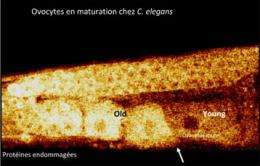Understanding ageing by studying reproduction benefits

Do examples of rejuvenation exist in nature? Yes, during reproduction! For the first time, a team from the Laboratoire de Biologie Moleculaire de la Cellule at CNRS (France) has managed to visualize, in the model organism C. elegans, the sudden "rejuvenation" of oocytes just before fertilization. Published in the journal Aging Cell, this work opens new avenues for understanding ageing and the diseases that are associated with it.
Traditionally, studies on aging compare elderly individuals with younger individuals or normal individuals with individuals with proven longevity. A study carried out by Hugo Aguilaniu's team at the Laboratoire de Biologie Moléculaire de la Cellule tackled the issue under a conceptually new angle: do examples of rejuvenation exist in nature? They do indeed, quite simply during reproduction! The scientists sought to understand why newborn babies do not inherit the same risks of developing ageing diseases, such as cancers, as their parents.
What are the potential genetic mechanisms for this “rejuvenation"? The researchers based their work on a model organism for ageing studies, C. elegans. This nematode worm is small, transparent, hermaphrodite, and capable of self-fertilization. It reproduces very quickly and makes it possible to monitor every step of fertilization in a single organism.
Over time, carbonylation and oxidation damage proteins, the main constituent of our cells, and can therefore act as ageing markers. In their study, the scientists developed a technique to “visualize”, in oocytes, the level of oxidation of proteins in cells. They firstly noted that the germline (of gametes) is oxidized, precluding the idea that the germline does not age. But, above all, they showed that at a precise stage of maturation of the oocytes the level of oxidation dropped suddenly. How? The researchers highlighted the role of the proteasome (which serves to degrade proteins) in this process. When it is inhibited, “rejuvenation” occurs with difficulty or not at all, thereby leading to sterility. During reproduction, the proteins in our cells are therefore “cleansed” and rejuvenated to form new, young individuals.
This study paves the way for a number of fascinating biological questions: what must individuals inherit from their parents and, on the other hand, what must they not inherit? How do we manage, each time we reproduce, to reduce the incidence of aging diseases (cancer, neuro-degeneration, etc.)?
More information: Carbonylated Proteins are Eliminated During Reproduction in C. elegans, Jerome Goudeau and Hugo Aguilaniu, Aging Cell, Volume 9, Issue 6, pages 991-1003, December 2010.















